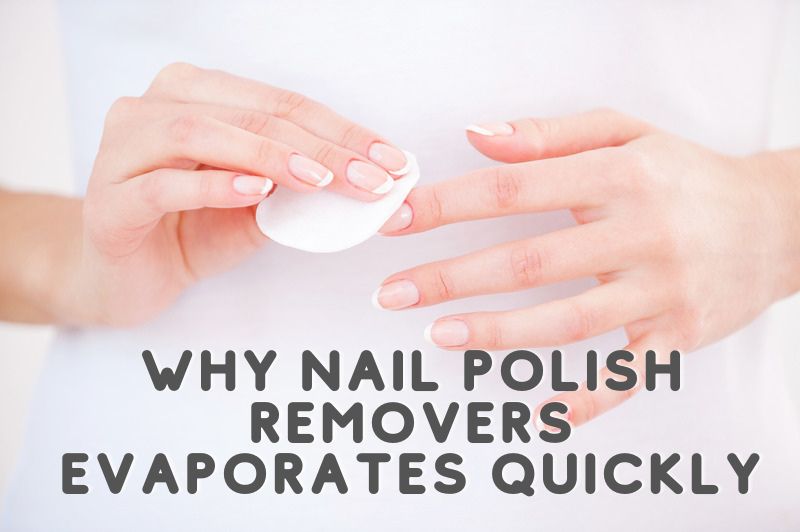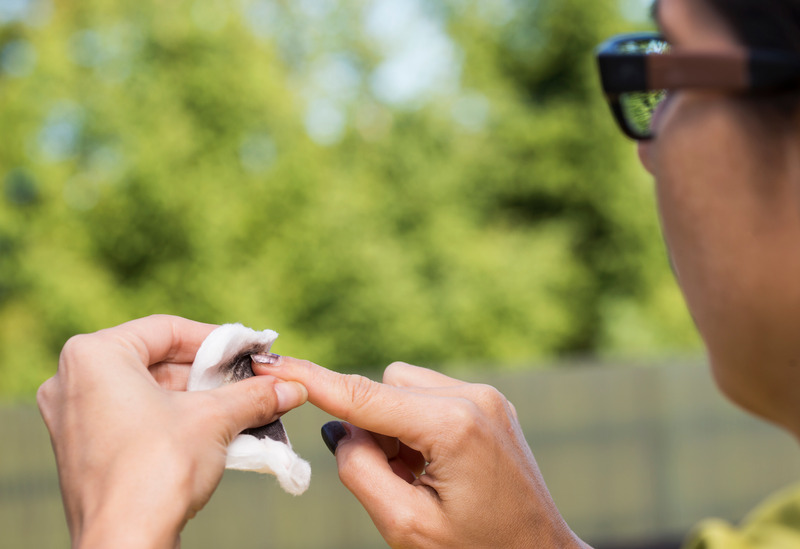Nail polish removers are industrially made to contain ingredients such as; ethyl acetate, isopropyl alcohol and most importantly Acetone which is germane to some of its special features which would be explained further. Nail polish remover was made in order to switch between different shades of nail polishes or perhaps permanently remove one when the user has achieved it.
One key feature worthy of note about nail polish removers is their quickness to evaporate on application. That is, they disappear in no time after applying them. You may want to know “Why nail polish removers evaporates quickly?”

Nail polish removers evaporate quickly due to the presence of Acetone, the solvent for most nail polish removers which has lower energy of vaporization and boiling point than ordinary water.
More About Acetone
Acetone is an organic compound with the formula (CH3)2CO. it is the smallest and simplest form of the ketone. It occurs naturally in plants, trees, vehicles exhaust, and forest fires, and also as a breakdown product of animal fat metabolism.
It has the following physical properties:
- It is colorless.
- It is highly flammable
- It is highly volatile and stable under recommended storage conditions
- It has a pungent, sweetish taste
- It has a boiling point of 133 Fahrenheit at 760 mm Hg
- It has a characteristic pungent odor
Its chemical properties include:
1. Polymerization
Acetone can form two types of polymers and oligomers through the process of polymerization. One type can be acetone molecules linked with ether bridges, the other type can be obtained via repeated aldol condensation, with one water molecule removed every step.
2. Tautomerism
Acetone like most ketones exhibits tautomerism in which the nominal keto structure of acetone itself is in equilibrium with the enol isomer.
3. Aldol Condensation
Two acetone molecules combine to form diacetone alcohol compounds in the presence of suitable catalysts, which on dehydration produces mesityl oxide. Industrially, it is used as the following: laboratory chemicals, fuels, and fuel additives, adhesives and sealants chemicals, ion exchange agents, and agricultural chemicals.
It may also be used to remove grease or gum from textiles such as silk and wool, to make plastics, and to
manufacture lacquers for cars or furniture.
Even though acetone is the primary reason why nail polish removers evaporate fast, there is another reason why that can happen.

How Evaporation Works
Evaporation occurs when a liquid is transformed into gas usually in the presence of heat. This process always releases some of the molecules of such liquid into the air. How can this happen? you must wonder. Simply put, molecules need some amount of energy, and this energy varies from molecule to molecule. Evaporation has occurred when the molecules of one liquid have enough to transform into vapor, and Kinetic energy is what makes these molecules move.
You must be wondering if Acetone in nail polish removers is what makes them evaporate quickly, what about non-acetone nail polish removers?
Non-acetone nail polish removers essentially contain ingredients like ethyl acetate or methyl ketone as their active ingredient. Acetone nail polish removers reportedly carry health risks which may include excessive dryness of the nail and cracking, in contrast, to acetone-free nail polish removers which are considered gentler and less likely to cause excessive dryness. But they are equally considered when it comes to removing most types of varnishes from nails.
Why Nail Polish Removers Evaporates Quickly? Can You Stop Your Nail Polish Remover From Evaporating?
The answer is yes and no. There are instances where you can stop your nail polish remover from evaporating, and there are instances where you can’t. For instances where you can stop it; when you’re using your nail remover from a bottle, you can adopt the take-and-close method.
That is, close the bottle immediately you take enough amount you want to use at a time. That way, you will be avoiding unnecessary escape due to long exposure to the atmosphere.
Instances, where you can’t stop nail polish remover from evaporating, is when it’s out of the bottle and applied on nail surfaces. As soon as the nail polish remover has left its container, nothing can prevent it from actively reacting with environmental gases and mixing with them. So, when your nail polish remover is applied to your nails, it evaporates simultaneously.
Since it is established that we also can not stop nail polish removers from evaporating, how exactly long will a particular amount of nail polish remover taken out of its bottle take to evaporate you must wonder.
How Do You Keep Nail Polish Remover From Evaporating?
If you’ve ever had nail polish remover evaporate in an uncovered jar that you weren’t using, you know how frustrating it is to see a nice bottle of remover go from full to half empty in a few months. So here are some tips for how to get the most out of your nail polish remover:
1. Store opened bottles in a cool, dark place.
2. Close the lid tightly after each use, and don’t leave the bottle open for too long between uses.
3. If your nail polish remover is already half empty, try pouring it into another container and then store that in a cool place.

How Long Does Nail Polish Remover Take To Evaporate?
Since acetone is the main ingredient responsible for the quick evaporation of nail polish removers, the time it will take for a nail polish remover to evaporate will therefore depend on the percentage of acetone present in it. So nail polish remover evaporates really fast. It removes all types of nail polishes because it includes acetone and heat energy.
Some nail polish removers can have up to 30% acetone, some can have 50%, while some can have as high as 80%-100% based on the rate at which the manufacturers of the product want it to function.
So based on these rates, how long exactly will it take a nail polish remover to evaporate? You should know the higher the percentage of acetone content of a nail polish remover, the quicker it takes to evaporate. In the same vein, those with lower acetone content will take longer to evaporate. For more confirmation, you can attempt it at home yourself.
You can try out the experiment yourself
If you are considering doing it yourself at home, it is advisable to use a nail polish remover with acetone content ranging from 25%-50% to avoid bringing physical damage to your skin or cuticles. You should also use a small amount of about 5ml for your experiment to make it easier to handle and to also reduce the time to get results as more amount translates to more time it will take to get results.
You can place the same amount of water near it in order to compare the rate of evaporation between them. You will realize evaporation happens faster in the acetone than it does in the water while both at room temperature. The reason as previously mentioned is due to the stronger hydrogen bond in water than in acetone, thus the bond breaks easily in acetone allowing the molecules to escape freely into the atmosphere.
Nail polish remover evaporates fast is so fast that you can notice the difference in its level within a short period of time. Alternatively, you can put different amounts of acetone in different containers and leave them open. You will notice the difference in evaporation rates depending on the amount of acetone in the container.
Does nail polish remover evaporate faster than rubbing alcohol?
Yes, and it does for two reasons; Nail polish remover is basically acetone, which is extremely volatile as previously stated, rubbing alcohol on the other hand is less volatile, so the high volatility in acetone makes it highly reactive and quick to evaporate on exposure. Also, rubbing alcohol has stronger intermolecular forces or bonds, holding it together, and making it less reactive to external agents as compared to acetone, which has weak intermolecular forces.
Does nail polish removers have the highest rate of evaporation?
Due to fewer intermolecular bonds between them, Yes, Acetone has the highest rate of evaporation compared to other liquids like; water, alcohol, and petrol due to more intermolecular attraction between their molecules.
Conclusion
All the girls are using nail polish and then we have to remove nail polish. We all know that it evaporates quickly, but not everyone knew why.Nail polish remover evaporates so fast due to the acetone present in them. The rate at which they evaporate depends on the percentage of acetone presented.
Why does nail polish remover evaporate so fast?
Nail polish remover evaporates quickly due to its high volatility. Nail polish removers, typically containing acetone or other volatile solvents, have low boiling points, which means they can easily transition from a liquid to a gas state at room temperature. This rapid evaporation allows the remover to effectively dissolve and remove nail polish from the nails.
How quickly does nail polish remover evaporate?
Nail polish remover can evaporate relatively quickly, typically within a few minutes to several minutes, depending on factors such as the type of remover, the amount applied, and environmental conditions like temperature and airflow.
How do you keep nail polish remover from evaporating?
Nail polish remover can evaporate relatively quickly, typically within a few minutes to several minutes, depending on factors such as the type of remover, the amount applied, and environmental conditions like temperature and airflow.
Does nail polish remover evaporate completely?
Nail polish remover can evaporate relatively quickly, typically within a few minutes to several minutes, depending on factors such as the type of remover, the amount applied, and environmental conditions like temperature and airflow.
